Chameleon for Event Tracking: Features, Pricing, and Review
Looking for an effective Event tracking tool and wondering if Chameleon is the best option for your SaaS company?
With numerous Chameleon alternatives, it can be challenging to make a final decision.
In this article, we’ll delve into precisely that – helping you determine whether Chameleon is the ideal choice for your Event tracking needs. We’ll explore its features, pricing, and offer a comprehensive review to aid in your decision-making process.
Let’s get started!
TL;DR
- Chameleon is a good choice for Event tracking and it comes with features such as behavioral analytics, feature tags, user journey mapping, and user segmentation.
- Despite its strong performance when it comes to creating personalized and highly customized user experiences, Chameleon is not the most competitive tool when compared to similar products.
- Here are three reasons why you might need to look elsewhere:
- You are on a budget: To get access to all the needed tools for proper onboarding and adoption, you need to pay for the higher plans that can get expensive.
- Requires CSS knowledge: Custom CSS works by targeting specific elements of Chameleon Experiences to change their styling. However not all users have an idea what CSS is all about, so, you need to be technically savvy.
- Analytics are not advanced: Chameleon doesn’t pose of robust analytics features like Userpilot does. You might want to consider another tool if you need accurate product and user analytics, without paying for additional tools.
- If you’re looking for a better option for Event tracking, Userpilot exceeds both functionality and value for money compared to Chameleon. Ready to see Userpilot in action? Schedule a demo today to explore its powerful Event tracking capabilities firsthand.
![]()
Looking for a Better Alternative for Event Tracking? Try Userpilot

What is Chameleon?
Chameleon is a product adoption platform. It enables SaaS teams to leverage real-time user data to build beautiful on-brand experiences, improve user onboarding, and drive product-led growth.
In addition, it empowers product teams to create and manage dynamic in-product experiences. With Chameleon, SaaS teams can now create beautiful product tours that help, guide, and delight their users throughout their journey. All of these are possible without coding!
Must have features of event tracking tools
Here’s what to look for when opting for event-tracking tools:
- No-code tracking – such as tracking user clicks, hovers, and form infills to understand the impact of your in-app flows on your growth goals and feature adoption.
- Custom events – including actions such as compelling account setup, setting up payment methods, and creating workflows to track feature usage and overall adoption progress.
- Goal tracking – tracking the optimal result or specific action, tracking users that achieved an event to measure how your flows are influencing user behaviors, including activation moments, feature adoption, upgrades, etc.
- User segmentation – such as new customers, free trial users, lifetime free users, power users, inactive customers, users with low MRR, users with low NPS, and churned users to understand them on a deeper level and create personalized in-app experiences.
- Integrations – to collect data across your tools and get more in-depth analytics.
Chameleon features for event tracking
User analytics empowers you to get an accurate, unfiltered analysis of your user experience with your product. You can use Chameleon to continuously collect in-product user feedback, create in-app guidance and make better-informed decisions.
- Integrations: Chameleon offers you access to integrate best-in-class user analytic tools like Segment, Mixpanel, Heap, FullStory, and other tools.
- Tracking capabilities: It can track different events in your user onboarding process. For example, you can track started tour, completed tour, exited tour, button clicked, and so on. Also, you get a real-time live summary of what’s going on in your product tours.

- Data collection: Use data schema to collect data through Chameleon schema Google sheet.
Basically, there are not many differences in user analytics use cases for both Userpilot and Chameleon. The latter is leading when it comes to integrations with user analytics tools.
Chameleon’s behavioral analytics
User behavior analytics (UBA) involves collecting, grouping, and analyzing users’ behavior data to make decisions that enhance your overall UX.
However, Chameleon doesn’t offer in-depth analytics features like setting your goals, which makes tracking a lot easier, and checking what your users are doing based on your previously defined key performance indicators.
Nevertheless, with a comprehensive analytics tool like Mixpanel, you can design user journeys to contrast new users with power users and understand what makes users stick.
Chameleon’s feature tags
Chameleon does not offer any functionality for feature tagging except for analytics and segmentation.
By incorporating tagging features and tracking events in your product, you can gain valuable insights into how your features are being used.
Tagging features and tracking events within your product provides you with a great view of your feature usage, and that’s what you get when you use Userpilot for feature tagging.
Chameleon’s user journey mapping
Journey mapping is key to understanding how your users navigate and understand your tool. It’s a brilliant way of visualizing the processes that customers go through to reach their goals.
Unfortunately, Chameleon doesn’t offer journey mapping features such as paths and funnels.
Chameleon’s user segmentation
“Chameleon has really helped us in combination with Segment to put the right offers in front of the right members at the right time. Before, we didn’t have the capability to build, target, and deliver on-site messaging to complex member audiences quickly and easily.”
Nate Wallingsford, Head of US Marketing Operations & Optimization.
Here’s a brief overview of Chameleon’s functionality in relation to segmentation:
- Target users with precision: Import or create user segments from Heap or Mixpanel.
- Power up user attribute data: Send user properties and attribute data to and from Chameleon.
- Experiment freely with A/B tests: Leverage segmentation to test the effectiveness of experiences.
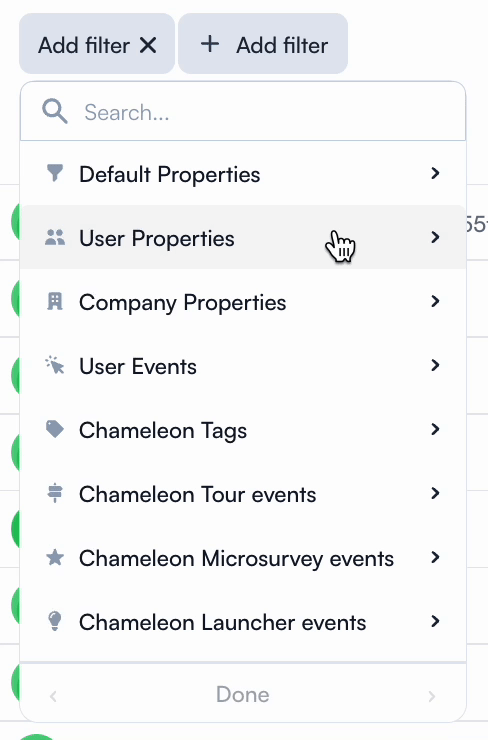
What are the pros and cons of Chameleon?
Chameleon’s pros
From a wide array of features to aesthetic UI patterns that can create any flow no matter how customized they need to be, Chameleon is no doubt a powerful tool for scaling product adoption.
It works in a similar way to Userpilot and offers similar features: styling, analytics, templates, goals, A/B testing, and checklists.
Let’s look at the pros of using Chameleon:
- Intuitive no-code builder: Chameleon comes with an easy-to-use Chrome Extension builder.
- Engaging tour guides: Build interactive tours to onboard users, announce features, and create other customer in-product experiences using simple steps.
- Good range of in-app messaging and UI patterns: Easy to create custom modals, slide-outs, tooltips, hotspots, launchers (checklists or resource hub), and more.
- Full two-way and deep analytics integrations: Chameleon fits into your stack, and easily connects with your favorite tools to send data to, and from Chameleon. It offers the deepest integrations, with analytics tools, CRMs, and more.
- Effective segmentation and targeting system: Leverage user data and experiences to structure effective marketing messages and tour guides for a specific target audience.
- Advanced A/B testing: Drive continuous improvement of in-app messages and define the ideal user experience with precise A/B testing.
- Rate limiting: No user wants to be overwhelmed with multiple product tours, in-app messages, and tasks. With rate limiting, you can reduce the number of user experiences — one step at a time, with clarity over speed.
Chameleon’s cons
While Chameleon is a deep production adoption tool with an array of great features, there are still some downsides. Here are the main cons of the tool:
- Not entirely no-code: Early on, we stated that Chameleon can be used without code. True. But it is not a completely no-code tool. You’ll need the help of a technical-savvy employee in your team to sort out some build-up as the learning curve is steeper.
- Hard-to-use interface: The new UI is a bit harder to use (a lot of clicking), and there can be minor bugs here and there.
- Limited experiences: There are some limitations to the user onboarding flows. For instance, you can’t run multiple in-app experiences at the same time, as you can in Userpilot.
- Pricey: The Startup plan is quite expensive (starts at $349/mo for 2500 MAU and includes just one launcher). This means you need to go for the Growth plan, where you pay more but save more at the same time.
What do users say about Chameleon?
Flexible, purpose-fit, intuitive, code-free (debatable), cool tools — so many great adjectives to describe the quality of Chameleon by its users.
Below are some good reviews by Chameleon users:
Chameleon offers a good variety of experiences that can be customized and the final output blends right into our customer interface. We like that they keep launching innovative features like the help bar and help menu, and we find the Chameleon UI initiative. The customer success managers are very supportive, prompt, and knowledgeable.
 While Chameleon has some great reviews, there are still some little downsides and quirks (same as every other SaaS tool). No tool is perfect — you need to realize that the satisfactory intent of every user is on a different level.
While Chameleon has some great reviews, there are still some little downsides and quirks (same as every other SaaS tool). No tool is perfect — you need to realize that the satisfactory intent of every user is on a different level.
The UI Itself is difficult to learn. There are hidden actions or language that is unintuitive on most pages. One example – It took me probably 20 minutes to figure out how to turn rate limiting off – our tour names can be long sometimes, so the trash can icon was out of frame to the right and the left-right scroll bar was out of frame at the bottom of my screen. When the tours are displayed. there doesn’t seem to be a uniform set of rules. They’re alphabetized on the rate limiting page, but organized by priority on the tours page. We also have a ton of old tours that have been unpublished but they still show up in the lists. I wish those were filtered to a second tab. Creating custom audiences could be streamlined as well.
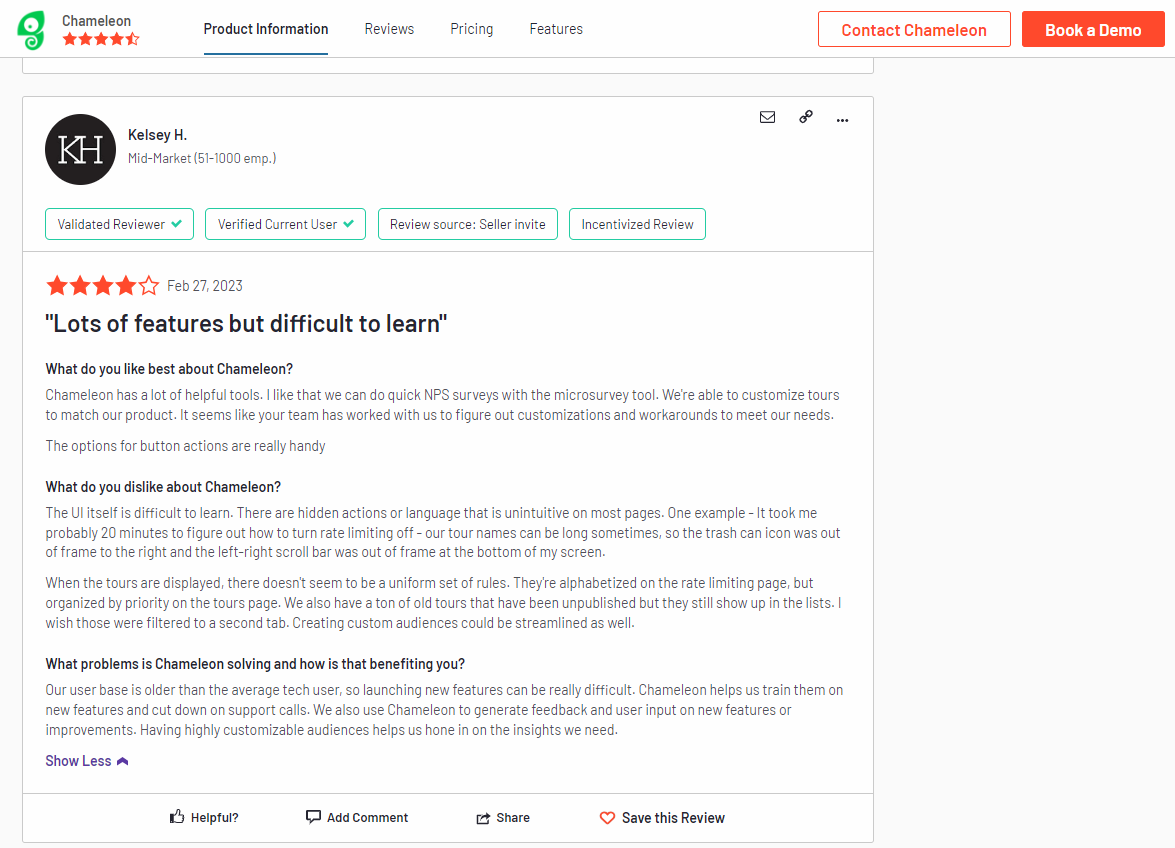
Chameleon’s pricing
Chameleon’s pricing is based on your product’s monthly users. From the Startup plan (for small companies to get started and save) to the Growth and Enterprise plans (for larger organizations with advanced requirements) billed via invoice.
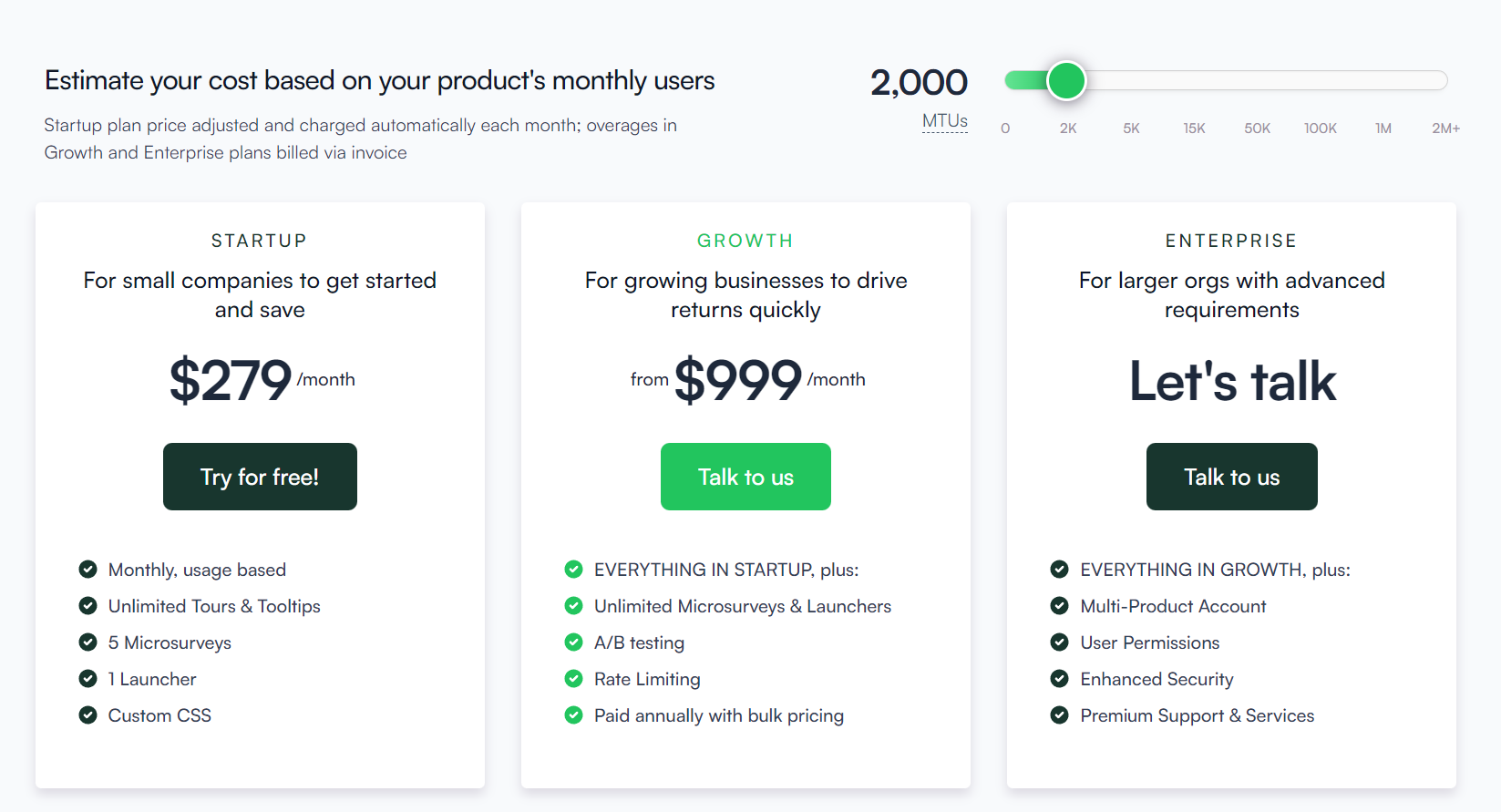
Here’s an overview of the pricing plans, and features of each plan:
- Startup plan: For small companies to get started. Fee: $419/month, billed Monthly, usage-based, Unlimited Tours & Tooltips, 5 microsurveys, 1 Launcher, Custom CSS.
- Growth plan: For growing businesses to drive returns quickly, from $1350/month. Everything in the startup plan, plus: unlimited microsurveys & launchers, A/B testing, and rate limiting is paid annually with bulk pricing.
- Enterprise plan: For larger organizations with advanced requirements. The fee for this plan is not stated on the website rather, you get to talk to the team. You get everything in the growth plan, multi-product account, user permissions, localizations, and SSO/enhanced security.
The Growth plan seems to be the real deal because of the exciting features that can boost your product marketing. For example, you can’t get the rate limiting feature on the Startup plan, including A/B testing. These are relevant and powerful product adoption weapons that should be in your arsenal if you truly want to win more users.
Is the startup plan expensive?
Yes, compared to Userpilot, about a $170 difference. It’s best to opt in for the Growth plan for the juicy benefits, where you pay $1350 annually rather than paying a whopping $5000+ yearly for the startup plan.
3 Reasons why you might need a Chameleon alternative
Despite its strong performance when it comes to creating personalized and highly customized user experiences, Chameleon is not the most competitive tool when compared to similar products.
Here are three reasons why you might need to look elsewhere:
- You are on a budget: To get access to all the needed tools for proper onboarding and adoption, you need to pay for the higher plans that can get expensive.
- Requires CSS knowledge: Custom CSS works by targeting specific elements of Chameleon Experiences to change their styling. However not all users have an idea what CSS is all about, so, you need to be technically savvy.
- Analytics are not advanced: Chameleon doesn’t pose of robust analytics features like Userpilot does. You might want to consider another tool if you need accurate product and user analytics, without paying for additional tools.
Userpilot – A better alternative for event tracking
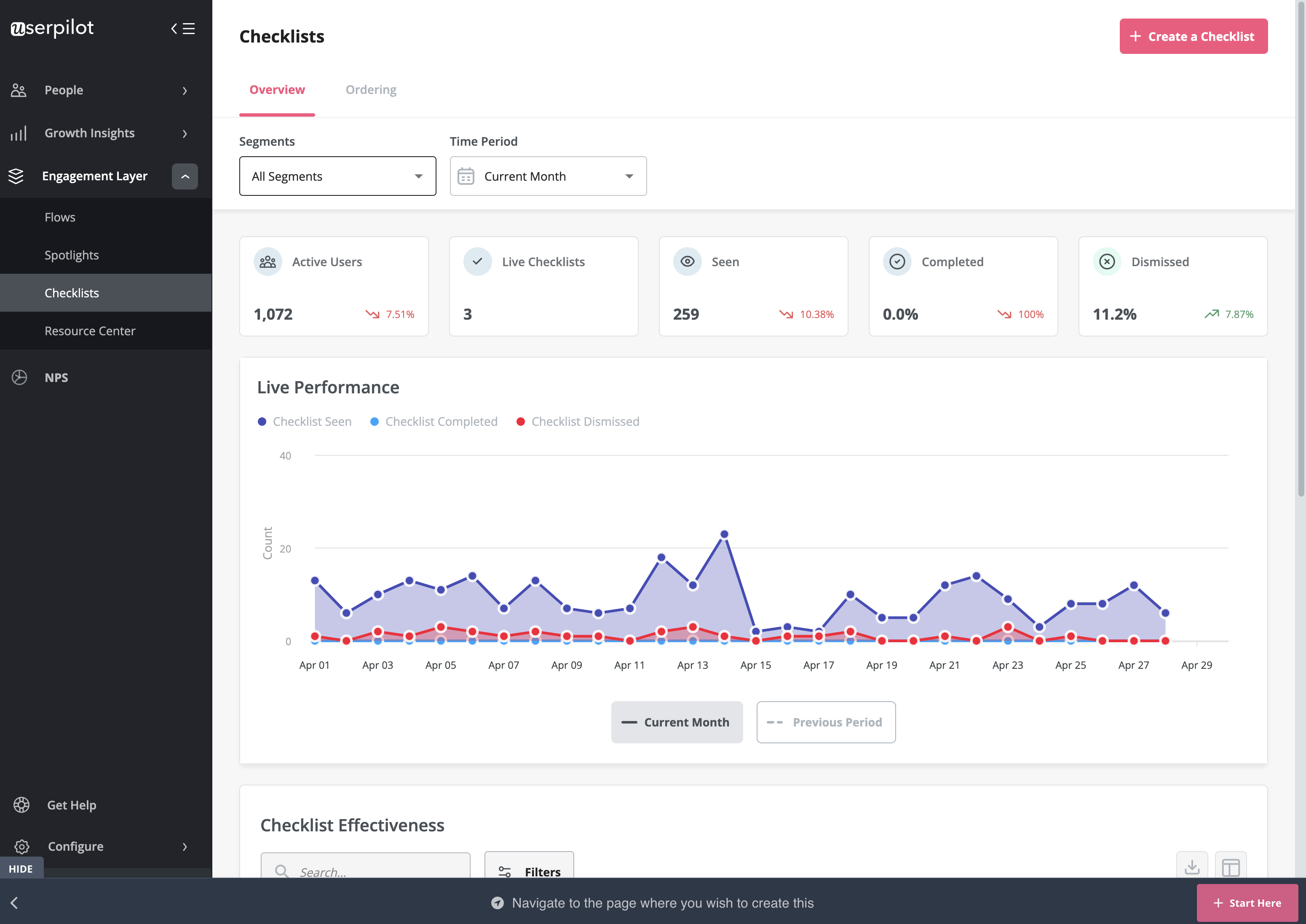 User analytics lets you track and analyze the behavior of users within your product. Userpilot lets you filter through customers from a unified dashboard, extract insights from specific segments or time periods, and create custom segments for all users who meet certain conditions.
User analytics lets you track and analyze the behavior of users within your product. Userpilot lets you filter through customers from a unified dashboard, extract insights from specific segments or time periods, and create custom segments for all users who meet certain conditions.
Here’s an overview of Userpilot’s analytics features:
- Users dashboard: Userpilot’s users dashboard gives you an overview of all user data in one place. You’ll be able to filter by segments, which companies users are from, or when they were last seen active. You can also export data in bulk as a CSV or perform actions on individual users.
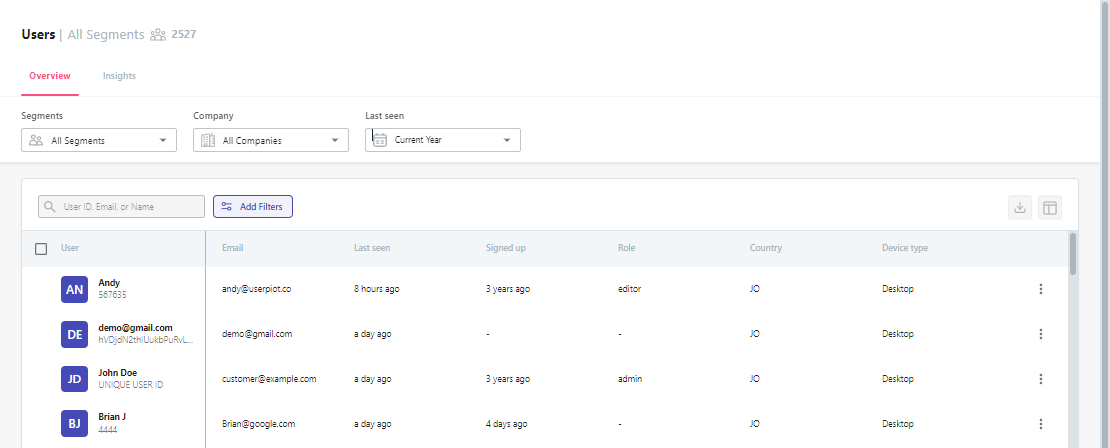
- Audience insights: Much like the overview dashboard, the Insights section lets you filter metrics by segment, company, and time period. You’ll be able to choose between a daily, weekly, or monthly view and then compare data between the current and previous time periods.

- Conditional segmentation: Practical use cases for user analytics include creating segments for all users that meet certain conditions. For instance, you could reach out to companies in a certain country when creating a new flow or target customers who have tried certain features.
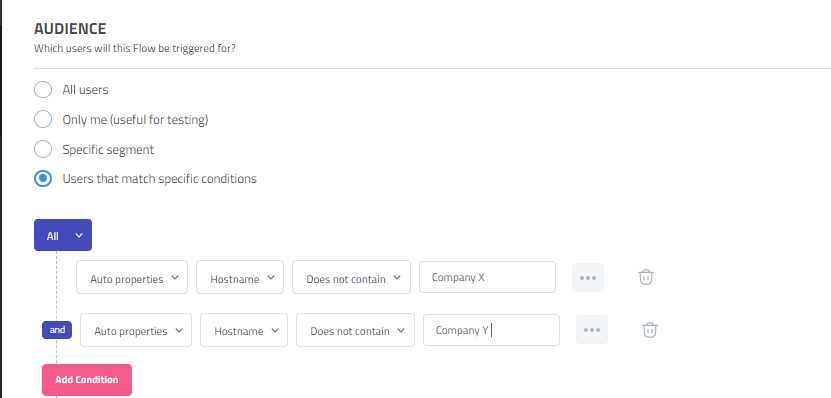
- Saved reports: The saved reports dashboard lets you view, edit, duplicate, or delete any trend and funnel reports you’ve created. You’ll also be able to sort by report type, filter by the teammate who created the report, or export in bulk if you need a CSV of your user analytics.

Userpilot’s behavioral analytics
Behavioral analytics make it possible to monitor user activity, group data into cohorts, and extract relevant metrics/insights. Userpilot lets you tag features to see how users interact with them, compare goals by cohort, and create trend reports that track behavioral patterns over time.
Here are some Userpilot features you can use for user behavior tracking:
- No-Code Feature Tagging: Userpilot’s click-to-track feature tagger lets you mark features, buttons, and elements with the Chrome extension. You’ll be able to track user interactions such as clicks, hovers, or inputs to get an accurate behavioral view for specific features.

- Funnel Reports: Funnel reports show you the total number of users that enter a funnel and the percentage of users that complete each step. This can help you track behavioral paths and see which stages most users get stuck on.
- Trends Reports: Generating trends reports will help you visualize the occurrence of key events over time and break down these analytics by device, browser, operating system, country, signup date, or even individual user IDs and email addresses to see granular behavioral analytics.
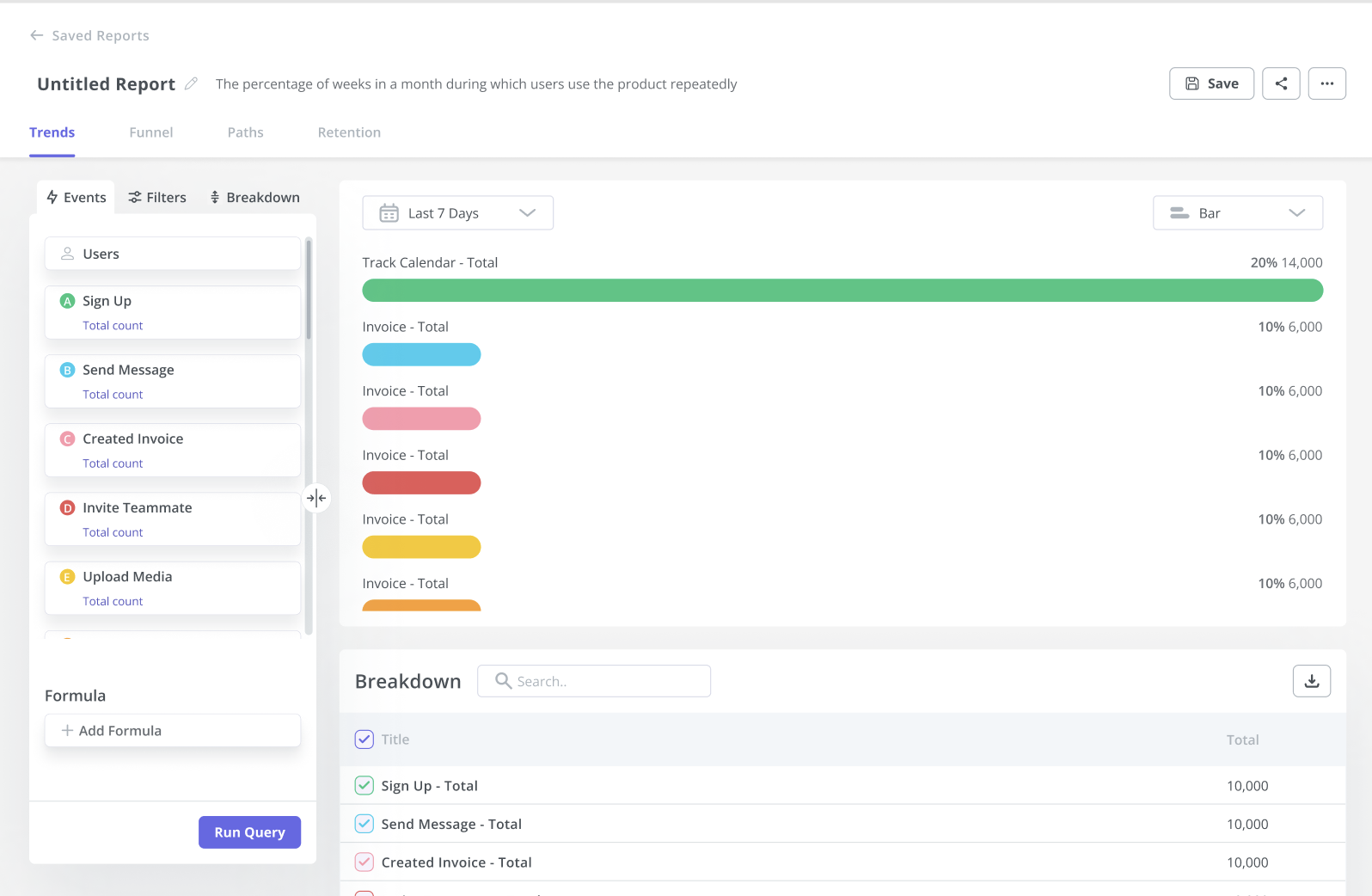
Userpilot’s feature tags
Tracking feature adoption is essential to identify under-utilized features and push users toward discovering them. Userpilot lets you tag features without writing any code, track adoption through engagement analytics, and visualize feature usage with heatmaps.
Here’s how you can use Userpilot to conduct feature audits and drive feature adoption:
- No-code tagging: Userpilot’s no-code feature tagger lets you add tags through the Chrome extension’s visual builder. You’ll also be able to select whether the tag should track clicks, hovers, or text inputs from users to get contextual data that reflects actual feature usage.
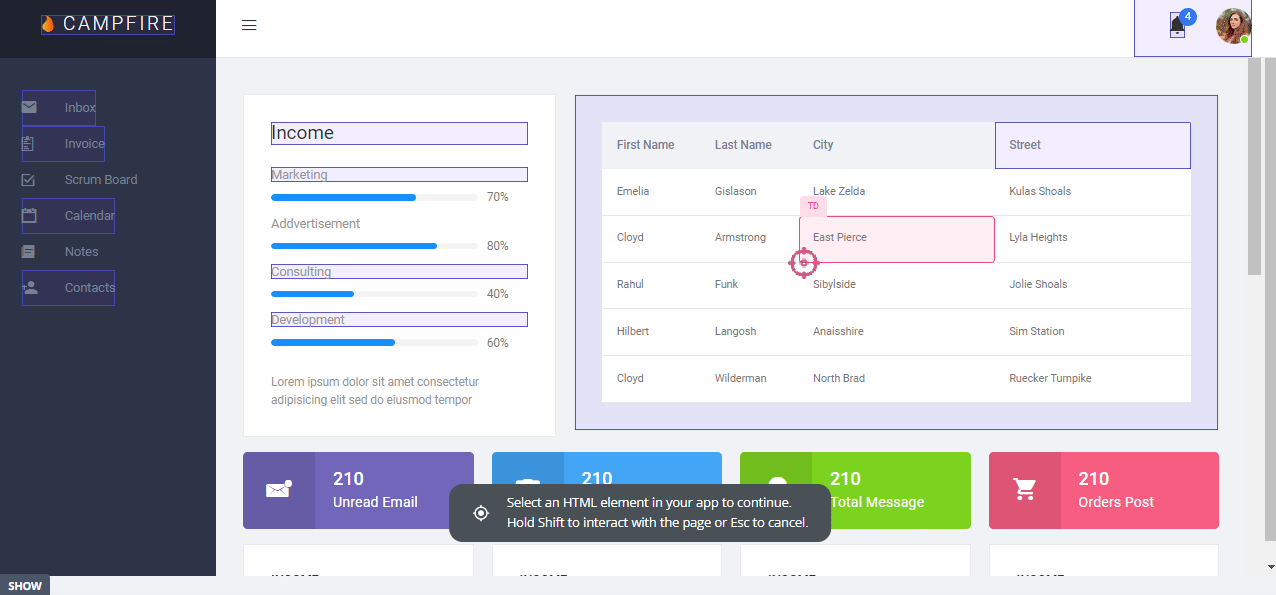
- Feature tags: The advanced feature analytics of Userpilot lets you track feature performance trends, see the top 20 features across your user base, and see granular data for individual features. You’ll also be able to filter your data by segment, company, or time period.
- Usage heatmaps: Userpilot heatmaps show you the features/elements with the most interactions. Heatmaps can be generated on the Features & Events dashboard by clicking on a tagged feature, editing it in the builder, and then clicking the heatmap icon on the bottom toolbar.
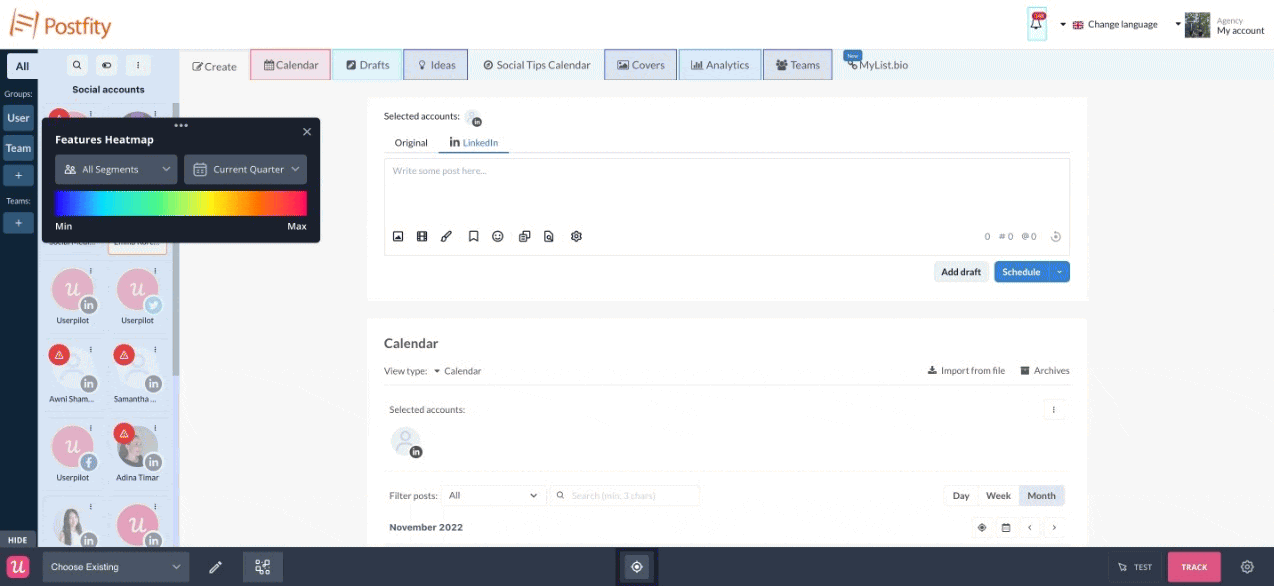
Userpilot’s user journey mapping
User journey mapping helps you visualize all the interactions between users and your product as they try to achieve a particular goal. Userpilot’s detailed user analytics and funnel/trend reports help you track customers as they progress through different stages of their journey.
Here are the Userpilot features you can use for user journey mapping:
- User analytics: The Users dashboard provides detailed analytics of your entire customer base. You’ll be able to sort by segment, company, or time period and add multiple filters to help you narrow results. You can also perform bulk actions and export user data in a CSV format.
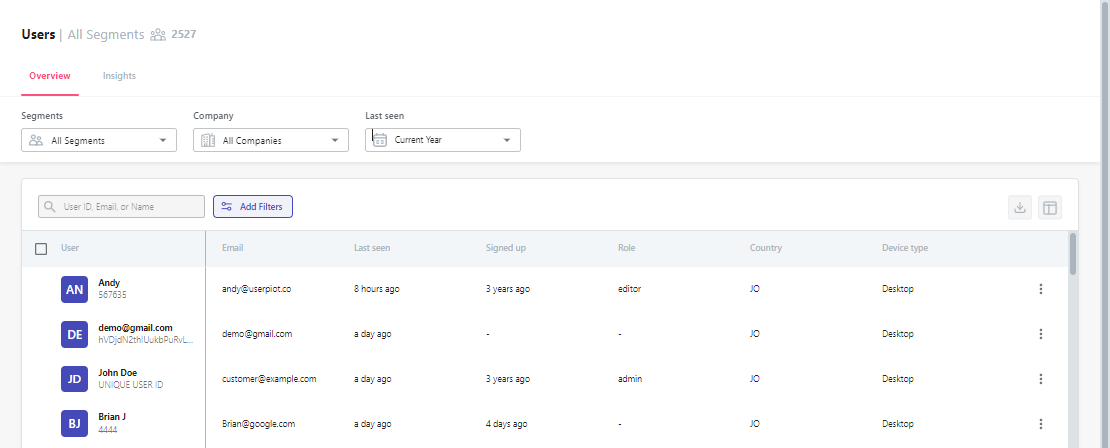
- Funnel reports: These reports help you visualize the user journey map by showing which stage, page, or action most users get stuck on. You’ll also be able to view breakdowns so you can see how the user journey changes depending on which OS, browser, or device type a user is on.
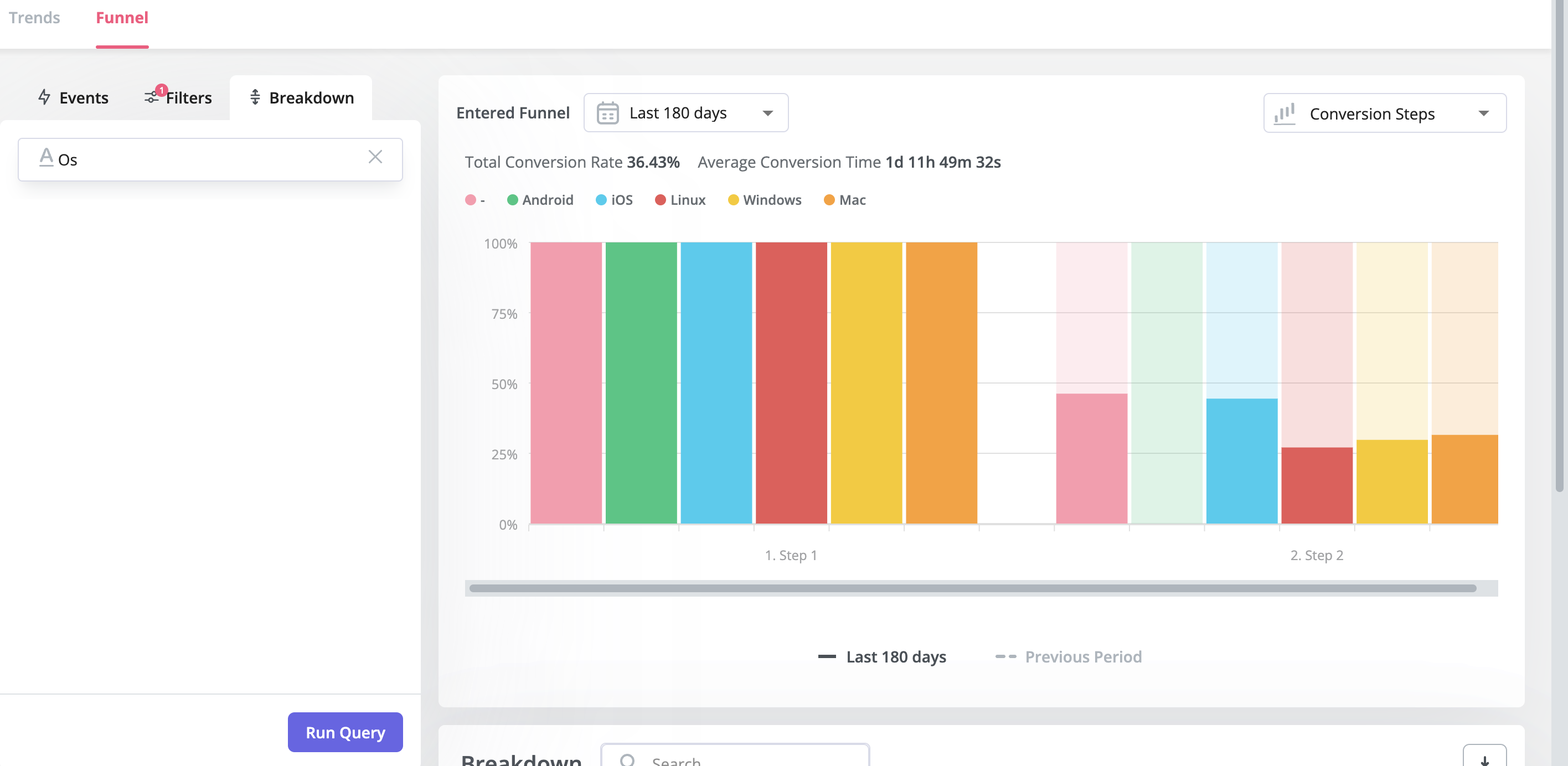
- Trend reports: Userpilot’s trend reports offer behavioral insights such as how often users perform a specific action, the number of unique users who take that action, and where in the user journey these actions occur. You can also create custom metrics and build your own charts.

Userpilot’s user segmentation
User segmentation is essential for creating a personalized and contextual onboarding experience. Userpilot can segment users based on demographics, product usage data, NPS scores, and more. You can then trigger flows or filter analytics based on segments.
Here’s an overview of Userpilot’s customer segmentation capabilities:
- Segment conditions: Userpilot lets you form segments by adding different conditions like user data, company data, features and events, etc. You can then use these segments as analytics filters or flow triggers later on.
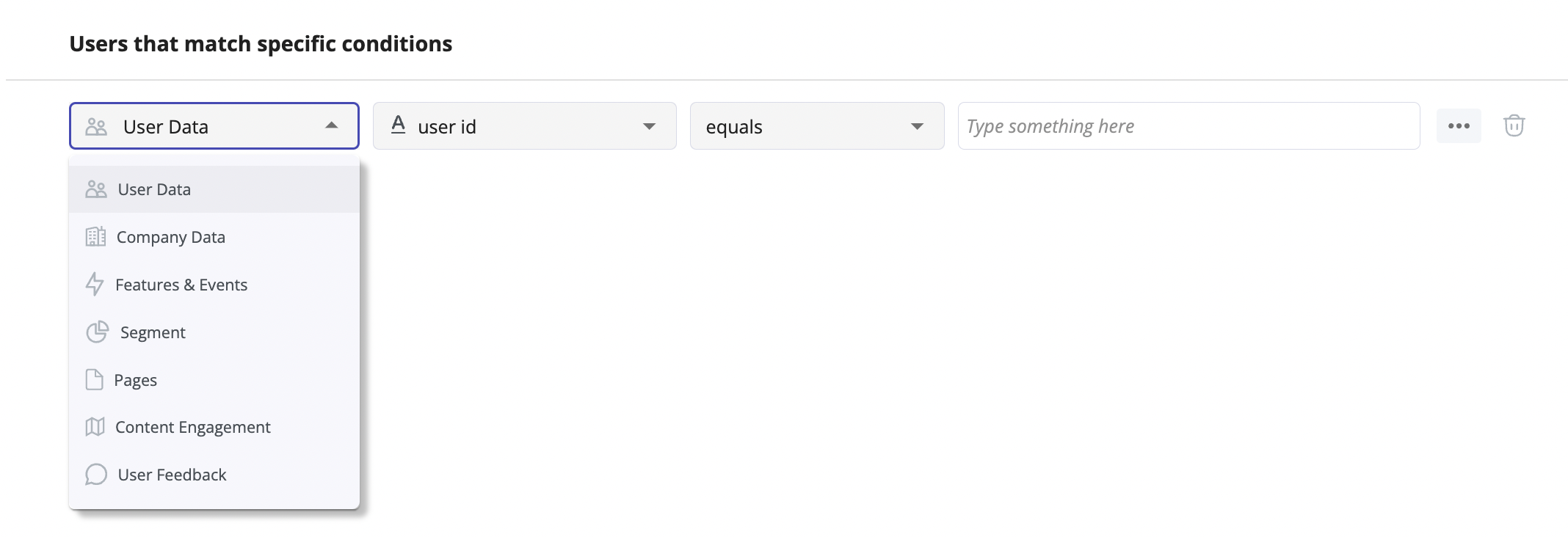
- Analytics filters: Userpilot’s product analytics and user insights dashboards can be filtered to only display data from specific segments (or companies). This will help you extract insights from certain cohorts and compare how adoption or activation varies from one segment to the next.
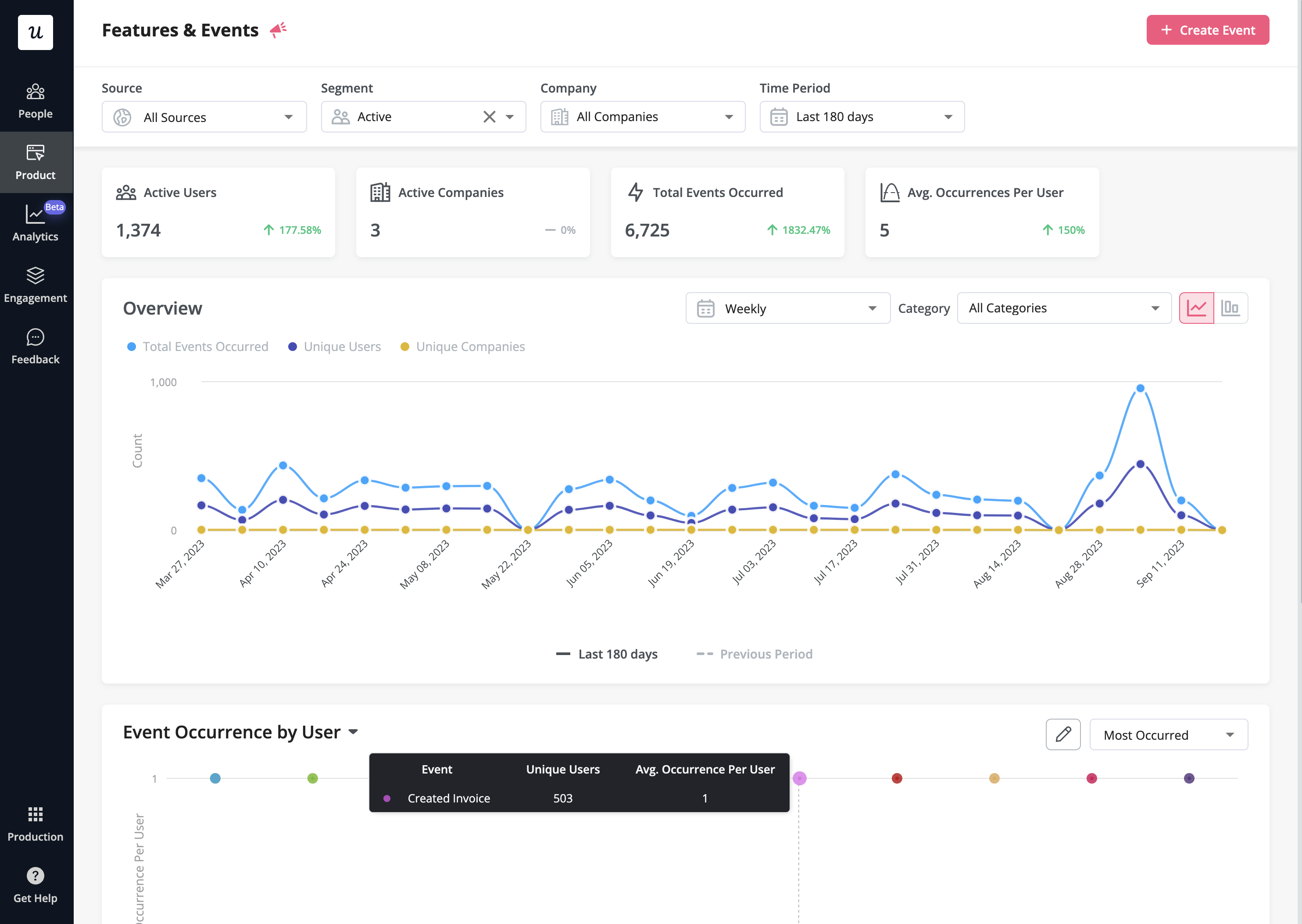
- Flow triggers: Userpilot’s audience settings let you trigger flows for specific segments or target users that meet certain conditions. You can combine this with page-specific or event-occurrence triggers to show relevant flows to the right users at the most contextual moments.

- External data: Userpilot integrates with tools like Amplitude, Google Analytics, Mixpanel, and Segment using a one-way integration. This means you can use the data inside Userpilot to build advanced segmentation and trigger contextual experiences. For more advanced use cases, the two-way integration with Hubspot lets you send and receive data, unlocking a full set of use cases.
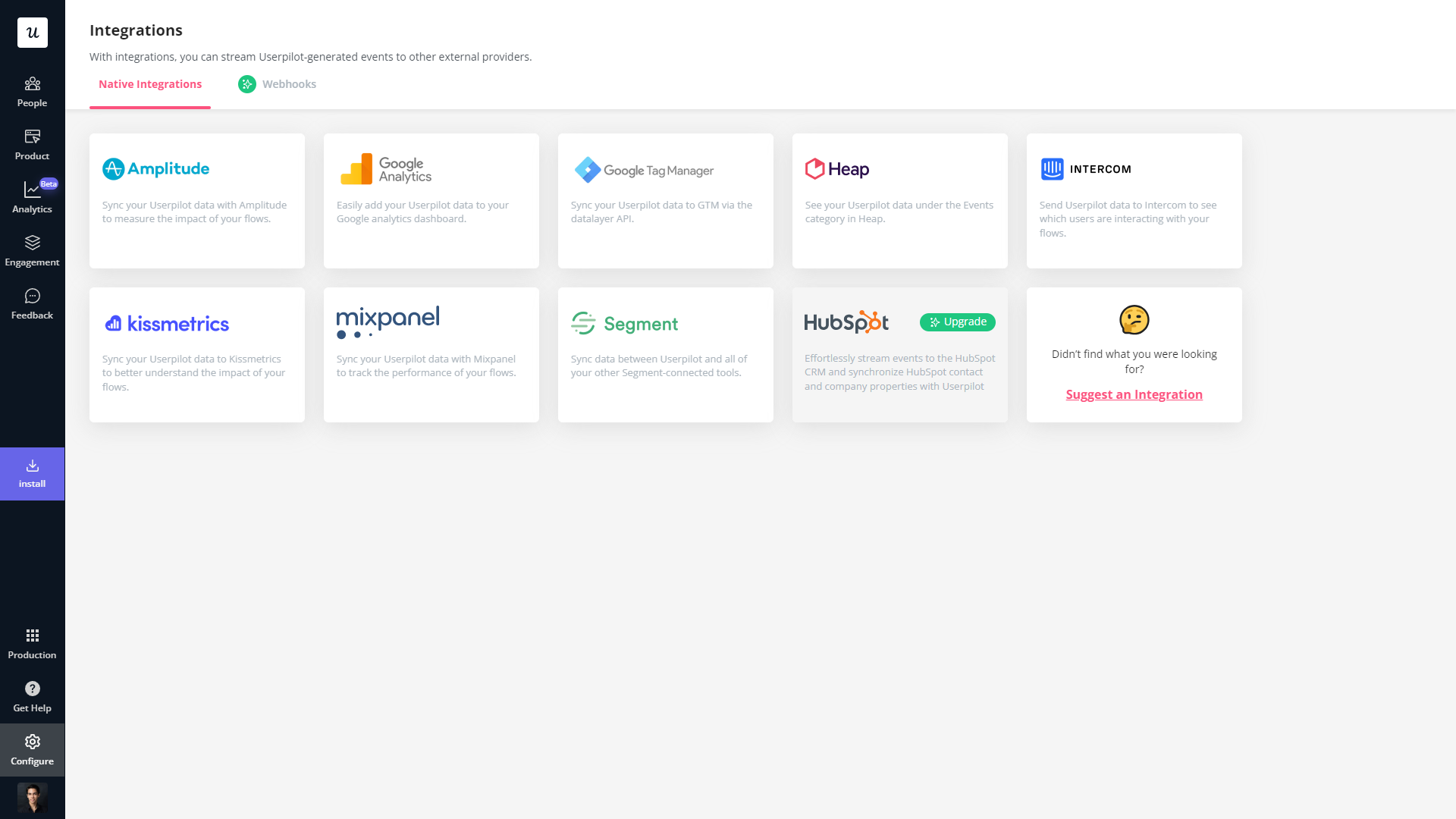
What are the pros and cons of Userpilot?
Userpilot pros
As a full-suite digital adoption platform, Userpilot has all the features you need to onboard users, track analytics, and gather feedback from customers without writing a single line of code. Here are a few pros of using Userpilot as your product growth solution:
- No-code builder: Userpilot’s Chrome extension lets you build flows, add UI elements, and tag features without writing a single line of code.
- UI patterns: There are plenty of UI patterns to choose from when using Userpilot, such as hotspots, tooltips, banners, slideouts, modals, and more!
- Startup-friendly: Userpilot’s entry-level plan gives you access to all available UI patterns so you can hit the ground running.
- Walkthroughs and flows: Build engaging interactive walkthroughs and personalized onboarding flows that target specific segments of your user base.
- Self-service support: Build an in-app resource center to help users solve problems, customize its appearance to align it with your brand, and insert various types of content (videos, flows, or chatbots) to keep your customers satisfied.
- A/B testing: Userpilot’s built-in A/B testing capabilities will help you split-test flows, iterate on the best-performing variants, and continually optimize based on user behavior.
- Feedback collection: Userpilot has built-in NPS surveys with its own unified analytics dashboard and response tagging to help you retarget users. There are other survey types to choose from and you can even create your own custom survey.
- Survey templates: There are 14 survey templates to choose from so you can gather feedback on specific features or run customer satisfaction benchmarking surveys like CSAT and CES.
- Advanced analytics: Userpilot lets you analyze product usage data, monitor engagement on all in-app flows, and use the data to create user segments that are based on behaviors instead of demographics.
- Event tracking: Userpilot’s no-code event tracking lets you tag UI interactions (hovers, clicks, or form fills) and group them into a custom event that reflects feature usage.
- Third-party integrations: Userpilot has built-in integrations with tools like Amplitude, Mixpanel, Kissmetrics, Segment, Heap, HubSpot, Intercom, Google Analytics, and Google Tag Manager so you can share data between all the solutions in your tech stack.
Userpilot’s cons
Of course, no tool is perfect and there are a few cons to consider before choosing Userpilot as your user onboarding or product growth solution:
- Employee onboarding: Currently, Userpilot only supports in-app customer onboarding.
- Mobile apps: Userpilot doesn’t have any mobile compatibility which could make it difficult for developers with cross-platform applications to create a consistent user experience for both versions of their product.
- Freemium plan: There’s no freemium Userpilot plan so those bootstrapping their startup and need sub-$100 solutions should consider more affordable onboarding platforms like UserGuiding or Product Fruits.
What do users say about Userpilot?
Most users laud Userpilot for its versatile feature set, ease of use, and responsive support team:
I recently had the pleasure of using Userpilot, and I must say it exceeded all my expectations. As a product manager, I’m always on the lookout for tools that can enhance user onboarding and improve overall user experience. Userpilot not only delivered on these fronts but also went above and beyond with its impressive new features, unparalleled ease of use, and truly exceptional customer support.
What truly sets Userpilot apart is its outstanding customer support. Throughout my journey with Userpilot, the support team has been responsive, knowledgeable, and genuinely dedicated to helping me succeed. Whenever I had a question or encountered an issue, their support team was always there to assist promptly, going above and beyond to ensure my concerns were addressed effectively.

Source: G2.
Of course, other users are also kind enough to share constructive criticism regarding specific features like event tracking filters:
“The filtration while analyzing specific events is a little confusing. Understanding of custom properties and data management configuration could have been more organised.”

Source: G2.
Userpilot’s pricing
Userpilot’s transparent pricing ranges from $249/month on the entry-level end to an Enterprise tier for larger companies.
Furthermore, Userpilot’s entry-level plan includes access to all UI patterns and should include everything that most mid-market SaaS businesses need to get started.

Userpilot has three paid plans to choose from:
- Starter: The entry-level Starter plan starts at $249/month and includes features like segmentation, product analytics, reporting, user engagement, user feedback, and customization.
- Growth: The Growth plan starts at $499/month and includes features like resource centers, advanced event-based triggers, unlimited feature tagging, AI-powered content localization, EU hosting options, and a dedicated customer success manager.
- Enterprise: The Enterprise plan uses custom pricing and includes all the features from Starter + Growth plus custom roles/permissions, access to premium integrations, priority support, custom contract, SLA, SAML SSO, activity logs, security audit and compliance (SOC 2/GDPR).
Conclusion
There you have it.
It should be easier now to make an informed decision whether Chameleon is your go-to option for Event tracking. Ultimately, the best choice will depend on your product and current needs.
If you’re looking for a better alternative to Chameleon for Event tracking, book a Userpilot demo today to experience firsthand how it can enhance your user experience and drive product growth!
![]()
Looking for a Better Alternative for Event Tracking? Try Userpilot


